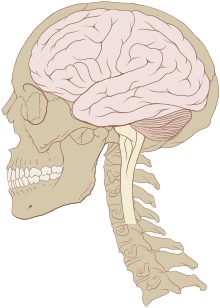|
Neuro-oncology
Neuro-oncology is the study of brain and spinal cord neoplasms, many of which are (at least eventually) very dangerous and life-threatening (astrocytoma, glioma, glioblastoma multiforme, ependymoma, pontine glioma, and brain stem tumors are among the many examples of these). Among the malignant brain cancers, gliomas of the brainstem and pons, glioblastoma multiforme, and high-grade (highly anaplastic) astrocytoma/oligodendroglioma are among the worst.[1] In these cases, untreated survival usually amounts to only a few months, and survival with current radiation and chemotherapy treatments may extend that time from around a year to a year and a half, possibly two or more, depending on the patient's condition, immune function, treatments used, and the specific type of malignant brain neoplasm. Surgery may in some cases be curative, but, as a general rule, malignant brain cancers tend to regenerate and emerge from remission easily, especially highly malignant cases. In such cases, the goal is to excise as much of the mass (tumor cells) and as much of the tumor margin as possible without endangering vital functions or other important cognitive abilities. The Journal of Neuro-Oncology is the longest continuously published journal in the field and serves as a leading reference to those practicing in the area of neuro-oncology. General informationPrimary tumors of the central nervous systemPrimary brain tumors can occur at any age, from infancy to late in life. These tumors often afflict people during their prime years. Factors such as age, tumor location, and clinical presentation are helpful in differential diagnosis. Most types of primary brain tumors are more common in men with the exception of meningiomas, which are more common in women.[2]  Metastatic tumors of the central nervous systemCancer spreads to the nervous system by direct invasion, compression, or metastasis. Direct invasion or compression from continuous tissues relates to the proximity of the nervous system to other structures, such as the brachial plexus, lumbosacral plexus, vertebral neuroforamina, base of skull, cranium, and pelvic bones.[2] Intracranial metastasisThere are three types of intracranial metastasis: brain metastasis, dural metastasis, and leptomeningeal metastasis. Brain metastasis can be single or multiple and involve any portion of the brain. Metastasis to dural structures generally occurs by hematogenous spread or direct invasion from a contiguous bone. Dural metastases can invade the underlying brain and cause focal edema and associated neurologic symptoms. These processes tend to cause seizures early in the course because of their cortical location. Metastasis to the leptomeninges is an uncommon but well-recognized clinical presentation in cancer patients. Leptomeningeal metastasis most commonly is due to breast, lung, or melanoma primary tumors.[2] Skull metastasisMetastases to the skull are divided into two categories by general site: calvarium and skull base. Metastases to the calvarium usually are asymptomatic. Metastases to the skull base quickly become symptomatic because of their proximity to cranial nerves and vascular structures.[2] Spinal metastasisThe spine most often is affected by metastatic disease involving the epidural space. This usually occurs as direct tumor spread from a vertebral body (85%) or by invasion of paravertebral masses through a neuroforamin (10–15%).[2] MechanismsTumor factorsHistologySeizures are common in patients with low-grade tumors such as dysembryoblastic neuroepithelial tumors, gangligliomas, and oligodendrogliomas. The rapid growth of fast-growing high-grade brain tumors may damage the subcortical network essential for electrical transmission, whereas slow-growing tumors have been suggested to induce partial deafferentation of cortical regions, causing denervation hypersensitivity and producing an epileptogenic milieu. Studies strongly suggest that genetic factors may play a role in tumor development and tumor-related epilepsy.[3][4] Glutamate neurotransmissionRecent work has demonstrated a close link between seizure activity and high extracellular glutamate in tumor-related epilepsy. Glutamate activation of ionotropic receptors leads to a rapid excitatory signal based on cation influx that can cause release of calcium from intracellular stores.[2] Initial patient evaluation and care1. Brain Tumor Presentations In general, patients with primary brain tumors or single metastatic tumors can present with any of these signs and symptoms, whereas patients with multiple brain metastases tend to present with generalized symptoms and may lack localized findings.[5] Several clinical features warrant special comment:
2. Spinal Cord Tumor Presentations
3. Approach to the Evaluation of New Patients The initial evaluation of a patient with a newly diagnosed tumor of the nervous system is a critical step toward appropriate management and patient care. The most important portions of the initial evaluation are a detailed history and a thorough examination. This process serves to identify the extent and nature of neurological deficit, provides diagnostic clues, can help disclose a source of metastasis, or may identify a genetic process associated with a primary central nervous system tumor.[5] 4. Practical Strategies for Providing Appropriate Patient Care There is no question that the clinical management of neurooncology patients is challenging. However, if we are to help patients and ultimately make advances in treating these tumors, meticulous and compassionate care of patients with neurological malignancies are crucial.[5]
Diagnostic proceduresDiagnostic imaging of the brain and spinal cordThe imaging studies commonly used in neurooncology are computed tomography (CT) and magnetic resonance imaging (MRI). Less commonly used are myelography, positron emission tomography (PET), and diagnostic angiography.[7][8] Lumbar puncture and cerebrospinal fluid analysisLumbar puncture (LP) and cerebrospinal fluid (CSF) analysis are important for the evaluation of some primary tumors, metastatic conditions, and neurologic complications of cancer.[7] Pathologic diagnosisAccurate histologic diagnosis is critical for treatment planning and patient counseling. Surgically obtained tissue usually is required to make a histologic diagnosis. For certain tumors, a definitive diagnosis can be accomplished by vitreous aspirate, cerebrospinal fluid (CSF) cytology, or suggested by the presence of certain tumor markers in the CSF.[7] Commonly used treatments
References
External links
Information related to Neuro-oncology |
